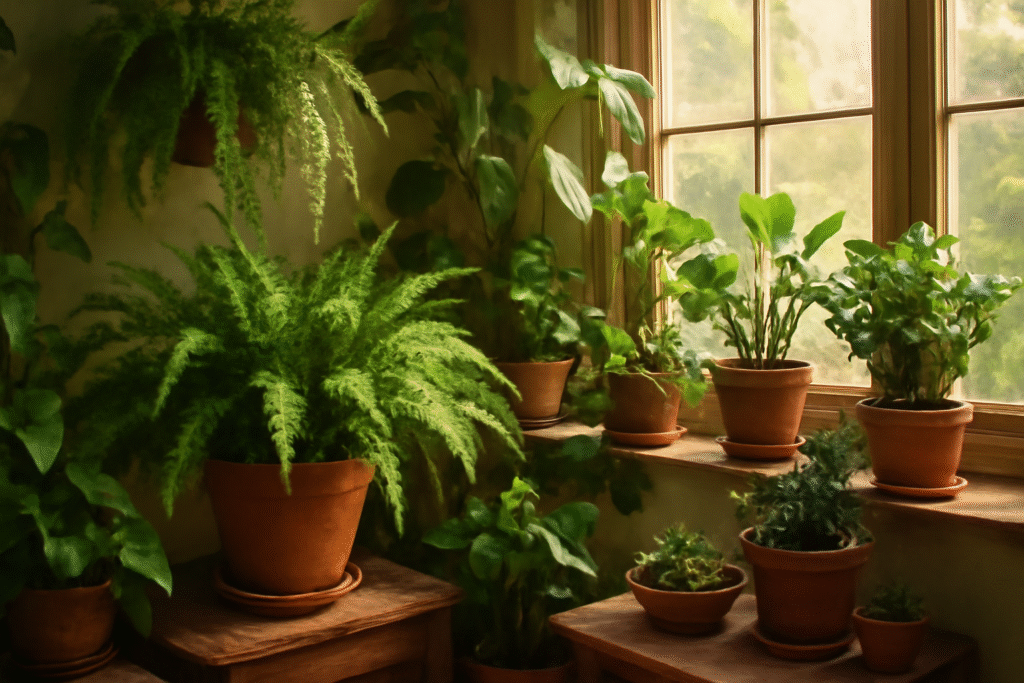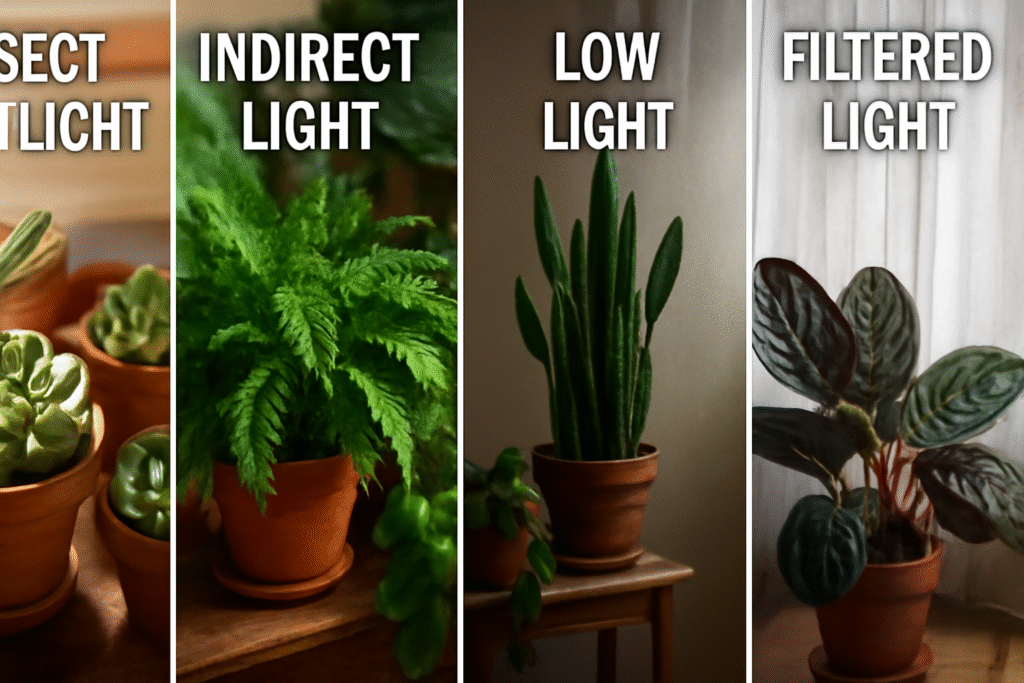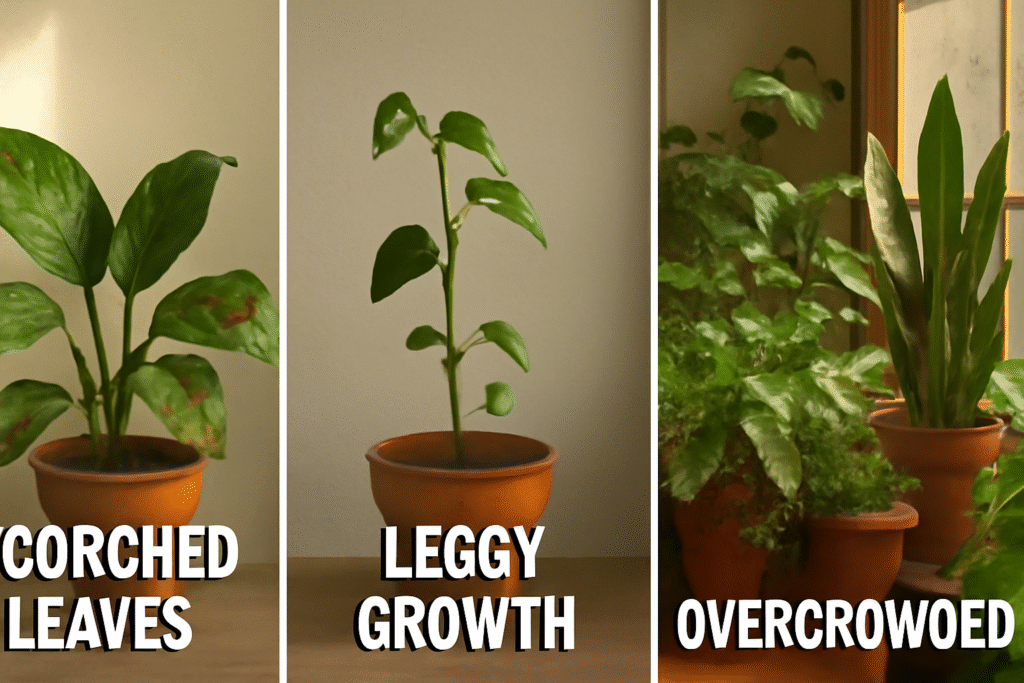
Positioning Indoor Plants for Optimal Light: A Complete Guide to Healthy Growth and Vibrant Greenery
Do you feel like your indoor plants just aren’t thriving the way they should? 
Light is essential for healthy plant growth, yet many of us unknowingly place our plants in spots that don’t meet their needs. Whether you’re a seasoned plant parent or just starting your indoor garden journey, understanding how to position your plants correctly can make all the difference between vibrant greenery and lackluster growth.
In this guide, we’ll walk you through how to position your indoor plants to ensure they get the light they need to thrive. From the best windows to understanding light intensity, you’ll learn actionable tips to bring your plants back to life and help them flourish like never before. Let’s get started on transforming your indoor garden into a vibrant, green oasis!
Table of Contents
ToggleTypes of Light – Knowing What Your Plants Need
Understanding the different types of light your indoor plants need is the first step to ensuring they thrive. Light isn’t just a “one-size-fits-all” situation—each plant has its own preferences. Let’s break it down so you can make the best decisions for your leafy friends!
Direct Light 
Direct light is when sunlight hits your plant straight from the window, typically at full intensity. This is ideal for sun-loving plants like succulents, cacti, and some flowering plants. If your plant is near a south- or west-facing window, it’s likely getting plenty of direct light.
- Best for: Succulents, cacti, and other plants that require lots of sunlight.
- Tip: Be cautious of too much direct sunlight, as it can scorch the leaves of more delicate plants.
Indirect Light 
Indirect light is when the sun’s rays are either filtered through a sheer curtain or reflected off walls, ceilings, or other surfaces. This type of light is softer and more diffused, making it ideal for most indoor plants like ferns, pothos, and peace lilies.
- Best for: Most houseplants, including ferns, pothos, and peace lilies.
- Tip: Place your plants near east- or north-facing windows for optimal indirect light, as these windows typically provide a softer, more consistent light throughout the day.
Low Light 
Low light conditions are often found in areas far from windows or in rooms with minimal natural light. While no plant can survive without light, some plants thrive in low-light conditions. These plants are typically darker green, as they’ve adapted to conserve energy in less light.
- Best for: Snake plants, ZZ plants, and pothos.
- Tip: If you’re placing plants in low-light areas, opt for those that are naturally adapted to survive with less sunlight.
Filtered or Dappled Light 
This type of light occurs when sunlight passes through leaves or other objects before reaching your plant. It’s common under tree canopies or when light is reflected off windows. It’s perfect for plants that like a balance between bright and low light.
- Best for: Calatheas, ferns, and begonias.
- Tip: For filtered light, position your plant near a window where it can receive diffused sunlight throughout the day, such as behind sheer curtains or shaded by blinds.

Identifying the Best Spots for Indoor Plants
Finding the perfect spot for your indoor plants is key to their health and vitality. Every room has its own light conditions, and understanding how to match plants with the right location can make all the difference. Let’s dive into where you should place your plants based on their light needs.
East-Facing Windows 
East-facing windows provide soft, gentle morning light. This is ideal for plants that need moderate sunlight but not intense midday heat. The light here is steady, but not harsh, making it perfect for a wide variety of plants.
- Best for: Peace lilies, pothos, and ferns.
- Tip: Place plants that prefer indirect light near east-facing windows for a consistent, gentle light source throughout the morning.
South-Facing Windows 
South-facing windows receive the most sunlight throughout the day, especially in the winter. This bright, direct light is great for sun-loving plants. However, it can also be too intense for more delicate plants, so it’s essential to consider each plant’s needs.
- Best for: Cacti, succulents, and other sun-loving plants.
- Tip: If the light is too strong, place your plants a little further from the window or use sheer curtains to diffuse the sunlight.
West-Facing Windows 
West-facing windows get strong afternoon sunlight, which can be quite intense. While this type of light is great for plants that can handle the heat, it can scorch more delicate varieties.
- Best for: Plants that enjoy bright but not direct light, like geraniums or spider plants.
- Tip: Use sheer curtains to filter the light and prevent it from getting too harsh for sensitive plants.
North-Facing Windows 
North-facing windows typically offer low or indirect light, making them perfect for plants that thrive in low-light conditions. This light is softer and more diffused, ideal for shade-loving plants.
- Best for: Snake plants, ZZ plants, and dracaenas.
- Tip: If you’re placing plants here, choose those that don’t require too much sunlight and are okay with less light intensity.
Farther from Windows (Low-Light Areas) 
Not every plant needs to be near a window. Some plants can thrive in the corners of rooms or further from natural light sources, as long as they are positioned well for indirect light.
- Best for: Plants like the pothos or peace lily that tolerate low light conditions.
- Tip: If you don’t have a lot of natural light, you can supplement with grow lights to ensure your plants get the light they need.

Using Light Accessories to Maximize Plant Health
Sometimes, natural light isn’t enough to meet the needs of your plants, especially in low-light spaces or during the darker months. That’s where light accessories come in! From reflective surfaces to grow lights, these tools can help boost your plants’ health and growth. Let’s explore how you can use light accessories to give your plants the best chance to thrive.
Reflective Surfaces to Amplify Light 
One simple and cost-effective way to increase light for your plants is by using reflective surfaces. Light-colored walls, mirrors, or shiny materials can bounce light back toward your plants, helping them get more exposure without needing to move them closer to the window.
- Best for: Low-light areas or when you want to intensify light without changing plant locations.
- Tip: Place your plants near white walls, mirrors, or reflective furniture to amplify the light they receive. Just be cautious not to reflect harsh direct light onto sensitive plants.
Using Shelves or Stands to Position Plants for Better Light 
Elevating your plants can also help them get more light. Consider placing them on shelves or plant stands, particularly near windows, to maximize their exposure. By adjusting their height, you can position them at a spot where they receive the best light available in the room.
- Best for: Plants that prefer brighter light, like succulents or tropical plants.
- Tip: Make sure to rotate your plants regularly so all sides get an equal amount of light, preventing uneven growth.
Grow Lights for Low-Light Areas 
If your space lacks sufficient natural light, grow lights are a game-changer. These lights are specifically designed to simulate sunlight, making them perfect for plants that need more light than your home can provide. Grow lights come in a variety of types, such as LED, fluorescent, and incandescent, each with different benefits.
- Best for: Low-light spaces or plants that require higher light intensity than what natural light offers (e.g., herbs, tropical plants).
- Tip: Choose the right type of grow light for your plant. LED grow lights are energy-efficient and produce less heat, while fluorescent lights are ideal for plants that need bright but not intense light.
Choosing the Right Light Spectrum 
Different plants have different light requirements, so it’s important to use the right type of grow light that matches your plant’s needs. Plants typically thrive under either cool or warm light, depending on their natural environment.
- Cool light (blue spectrum): Best for leafy plants and promoting vegetative growth.
- Warm light (red spectrum): Ideal for flowering and fruiting plants.
- Tip: Look for full-spectrum grow lights, as they combine both cool and warm light, making them suitable for a variety of plants.

Understanding Seasonal Changes and Adjusting Plant Placement
As the seasons change, so does the amount and intensity of sunlight that your plants receive. This is crucial to keep in mind when positioning indoor plants for optimal light. 
Winter Light – Less Intense, But Still Vital 
During the winter months, the sun’s position shifts, and days become shorter. This means that even if your plants were basking in direct sunlight through a south-facing window in summer, they may now receive less light.
- What to do: Move your plants closer to windows to make the most of the weaker sunlight. Consider using sheer curtains to diffuse the light if it’s too harsh.
- Best for: Light-loving plants like succulents or citrus trees that still need a bit of sun, even in winter.
Spring and Summer – Maximizing Sun Exposure 
In spring and summer, the days are longer, and the sun is more intense. This is the time when your plants will generally get the most light, so it’s important to keep an eye on them to avoid sunburn or scorching.
- What to do: Move plants that prefer indirect light away from direct sun exposure to prevent them from getting too much heat. Alternatively, plants that thrive on direct light, like cacti and succulents, can be placed closer to windows or even outside, if possible.
- Best for: Sun-loving plants like cacti, succulents, and herbs that thrive in bright sunlight.
Autumn – Time to Adjust as Light Dips 
As autumn arrives, the intensity of sunlight starts to decrease, and the angle of light changes. This is the time to gradually move plants to areas that get a bit more light, or even introduce supplemental lighting.
- What to do: You may want to reposition plants closer to windows or move them to different spots where light is still abundant. It’s also a great time to start using grow lights in areas that don’t receive enough natural light.
- Best for: Plants that need moderate light but can handle less intensity, such as ferns or peace lilies.

Common Mistakes to Avoid When Positioning Indoor Plants
While it’s easy to assume that plants will thrive anywhere with some light, incorrect placement can lead to poor growth and even plant death. To ensure your indoor garden flourishes, avoid these common mistakes when positioning your plants for optimal light.
1. Placing Plants in Direct Sunlight Without Protection 
One of the most common mistakes is placing plants that need indirect light in direct sunlight. While some plants love full sun, many indoor plants—like ferns and peace lilies—can get scorched by harsh, direct sunlight. This leads to browning or crispy leaves.
- What to do: Ensure that plants that prefer low or indirect light are kept away from direct sunlight. Use sheer curtains to diffuse intense light or move them to a shadier spot.
2. Not Adjusting for Seasonal Changes 
Plants need different light levels throughout the year. In the summer, the sun is stronger, and in the winter, it’s weaker. Failing to move your plants to adjust for these changes can result in plants getting too much or too little light, leading to poor growth.
- What to do: Move your plants closer to windows in the winter, and adjust placement in summer to prevent sunburn. Monitor the light and adjust positioning based on seasonal shifts.
3. Ignoring Light Intensity 
Not all light is the same! Even though a room might seem bright, the intensity of the light could be too low for your plants. Placing plants that need high light in a dimly lit corner will cause them to become leggy or weak.
- What to do: Understand your plant’s light needs—if they need bright light, place them near south- or west-facing windows. If they need low light, try north-facing windows or corners where light is less intense.
4. Grouping All Plants in One Area 
While it may seem convenient to group all your plants together, this can lead to problems. Each plant has unique light requirements, and clustering them in one spot could leave some of them without the ideal conditions they need to thrive.
- What to do: Group plants with similar light needs together. For example, place all your low-light plants in one area, and your sun-loving plants near a window where they’ll receive plenty of light.
5. Overcrowding Plants in Front of Windows 
Placing too many plants right in front of a window might seem like a good idea, but it can actually block sunlight from reaching your plants. Plus, overcrowding can cause plants to compete for light, which can stunt growth.
- What to do: Leave some space between plants to allow light to reach all sides of each plant. Consider using shelves or plant stands to elevate them for better exposure.

Creating a Thriving Indoor Garden with Optimal Light
Positioning indoor plants for optimal light is key to ensuring they grow healthy, vibrant, and strong. By understanding the different types of light and adjusting your plant placement based on the seasons and specific light needs, you can create the perfect environment for your greenery to thrive.
Remember to avoid common mistakes like overexposure to direct sunlight, ignoring seasonal changes, and overcrowding plants. With a little observation and adjustment, you’ll quickly see the positive effects of giving your plants the right amount of light.
As you continue to experiment with plant placement, you’ll grow more confident in your indoor gardening skills and enjoy a flourishing, vibrant collection of plants year-round. Happy gardening!
Frequently Asked Questions (FAQs)
1. What is the best type of light for indoor plants?
The best light for indoor plants depends on their specific needs. Direct light is ideal for sun-loving plants like succulents, while indirect light suits most indoor plants like ferns and pothos. Low light works for plants like snake plants that don’t need much sun. Always check the plant’s light preference to ensure healthy growth.
2. Can indoor plants survive with artificial light?
Yes, many indoor plants can thrive with artificial light, especially if natural light is insufficient. Use grow lights that mimic sunlight to provide the correct light spectrum. LED grow lights are a great choice as they are energy-efficient and produce little heat, making them suitable for most plants.
3. How do I know if my indoor plant is getting too much or too little light?
If your plant’s leaves turn yellow, are scorched, or burn, it’s likely getting too much direct light. If the plant is leggy, with elongated stems or slow growth, it may not be getting enough light. Adjust its position or try using supplemental lighting as needed.
4. How can I maximize light for my indoor plants without moving them?
To maximize light without relocating plants, use reflective surfaces like mirrors, white walls, or light-colored furniture to bounce light back toward them. Sheer curtains can also diffuse harsh sunlight and prevent plant damage while still letting in ample light.
5. What is the best position for plants in winter?
During winter, the sun’s rays are weaker and lower in the sky. Place your plants closer to windows to maximize light exposure. Consider adding grow lights for supplemental lighting and ensure your plants are not exposed to cold drafts near windows.
6. How often should I rotate my plants for even light exposure?
It’s a good idea to rotate your plants every 1-2 weeks to ensure they get even light exposure. This prevents them from leaning toward one side or developing uneven growth. Turning your plants helps them grow symmetrically and healthily.
7. Can I place plants in a corner of the room with no direct sunlight?
Yes, many plants thrive in low-light conditions, such as corners of the room. Plants like snake plants or ZZ plants are ideal for these spots. If you have a plant that needs more light, consider using grow lights or moving it closer to a window.
8. How can I tell if my plant is getting the right amount of light?
Monitor your plant’s health for signs of stress. If it’s growing well and producing new leaves, it’s likely getting the right amount of light. On the other hand, if you notice yellowing leaves or slow growth, it could be a sign that it needs more or less light. Adjust its position or lighting accordingly.





